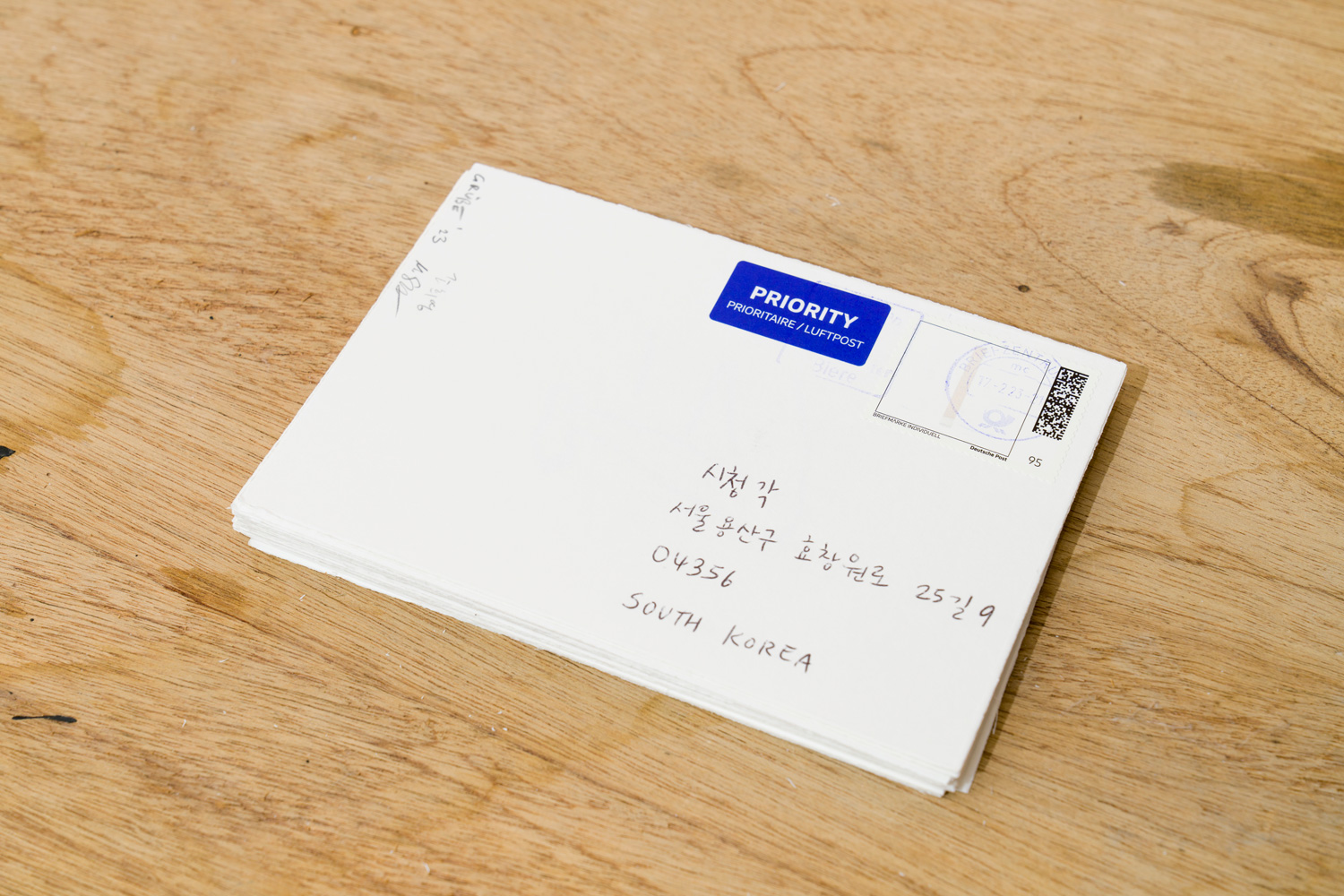
사진 김익현
은하계 여행자에게 수건은 필수품이다(적어도 『은하수를 여행하응 히치하이커를 위한 안내서』의 저자 더글라스 애덤스에게는): “실용적”이면서 여행자의 여행에 적합한 지위와 자격을 보여주는“폭넓은 심리적 가치”가 있다.
평범한 여행자에게, 수건의 상징적인 힘은 거의 필요가 없다; 여행을 떠나기 전 현실적인 생각: 수건이 필요한가?
여행용품을 선별할 때 결국 실용적으로 결정을 내리게 된다. (수건은 거의 어디에나 있는데, 굳이 챙겨야 하나?) 항공사를 예로 들면: 수하물은 최대 23킬로에, 규격도 이미 정확하게 정해져 있다. 따라서 여행 가방에 맞게 가장 효율적으로 넣는 것이 중요시된다.
요컨대, 여행자는 절제해야 한다.
여행자는 일정 내내 적합한 옷이나 장신구 등을 기능적이고 목적에 가장 충실할 것들로 결정해야 한다. “여행 갈 때 뭐 가져갈까?” – 진부하지만 거의 실존적인 질문이다. 여행 가방은 본의 아니게 아마도 동종 최고의 것들만 들어가는 엄선된 공간이 된다.
조희영과 마코 슈탕케는 여행 가방이라는 틀 안에서 이미지 생산의 확장된 형태를 탐구하는 역설적인 자유를 찾는다. 절제하는 동시에 과감히 재료를 변경한다. 줄이고, 나누고, 분리하고, 톱질하고 “쓸모 있는” 여행템(수건!)을 오용한다.
글쓴이 마코 슈탕케
번역 조희영

23
Photography by Ikhyun Gim
Für den intergalaktischen Reisenden ist das Handtuch ein unverzichtbarer Gegenstand (zumindest im Universum von Douglas Adams „Per Anhalter durch die Galaxis“): Neben seinem „großen praktischen“ hat es nämlich einen „immensen psychologischen Wert“, indem es dem Reisenden als Statussymbol dient, das ihn in seiner Reisetauglichkeit auszeichnet.
Für den gewöhnlichen Reisenden hat die Symbolkraft eines Handtuches wohl eher keine Bedeutung; eine realitätsnahe Überlegung vor Antritt einer Reise würde vermutlich lauten:
Brauche ich ein Handtuch oder nicht? Schließlich gilt Pragmatismus bei der Auswahl der Reiseutensilien als entscheidendes Kriterium (und Handtücher gibt es nahezu überall, warum also mitnehmen?). Beispiel Airlines: Das Standardmaximalgewicht für einen Reisekoffer liegt bei 23 kg, auch die Koffermaße sind genau vordefiniert. Folglich gilt abzuwägen, inwieweit sich die Kofferkapazität möglichst effizient ausreizen lässt.
Kurz gesagt: Wer reist, muss verzichten.
Der Reisende muss sich entscheiden, welche Gegenstände ihn die Reisedauer über begleiten sollen, welche Auswahl an Klamotten, Accessoires etc. ihren funktionalen oder repräsentativen Zweck bestmöglich erfüllen. „Was nehme ich auf meine Reise mit?“ – eine banale, aber dennoch geradezu existentielle Frage. Wider Willen wird der Reisekoffer zum streng kuratierten Ort, in dem wahrscheinlich nur die besten Stücke ihrer Art Einzug finden.
Heeyoung Jo und Marco Stanke finden in der Beschränkung des Reisekoffers eine widersprüchliche Freiheit, die es ihnen erlaubt, erweiterte Formen der Bildproduktion zu erforschen. Nicht nur durch Verzicht, sondern auch durch gravierende Eingriffe in den Bildträger: verkleinern, teilen, zerlegen, zersägen oder das Zweckentfremden „nützlicher“ Reisegegenstände (Handtuch!). Marco Stanke

23
Photography by Ikhyun Gim
For the intergalactic traveller, the towel is an indispensable item (at least in the universe of Douglas Adams’ “The Hitchhiker’s Guide to the Galaxy”): Besides its “great practical value”, it is also of “immense psychological value” and serves as a status symbol representing the traveller’s suitability for travel. For the ordinary traveller, the symbolic power of a towel is most likely of no significance; a realistic consideration before setting off on a journey would probably be:
Do I need a towel or not? After all, pragmatism is considered a decisive criterion when choosing travel utensils (and towels are available almost everywhere, so why pack one?). For example, airlines: The standard maximum weight for a suitcase is usually 23 kg, and its measurements are also precisely defined. Consequently, it is important to consider how the suitcase capacity can be used most efficiently.
In short: Who travels must make sacrifices. The traveller must decide which items should accompany him or her throughout the journey, which selection of clothes, accessories etc. will fulfil their functional or representative purpose in the best possible way. “What am I taking with me on my journey?” – a simple, yet almost existential question. Involuntarily, the travel suitcase becomes a strictly curated place where probably only the finest pieces of their kind find their way in.
Heeyoung Jo and Marco Stanke find a paradoxical freedom in the limitations of their suitcases that allows them to explore expanded forms of image production. Not only through renunciation, but also through serious modifications of the image carrier: by reducing, dividing, disassembling, sawing up or the improper use of “useful” travel items as art pieces (towel!).
Marco Stanke




